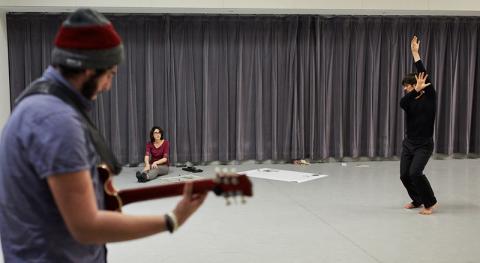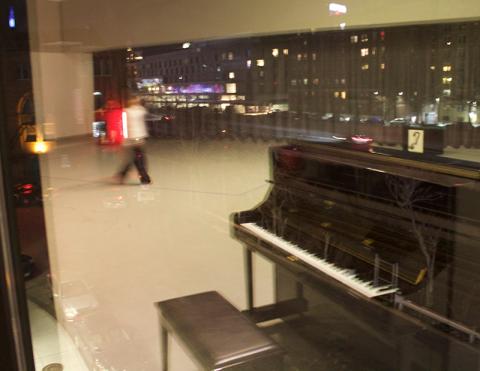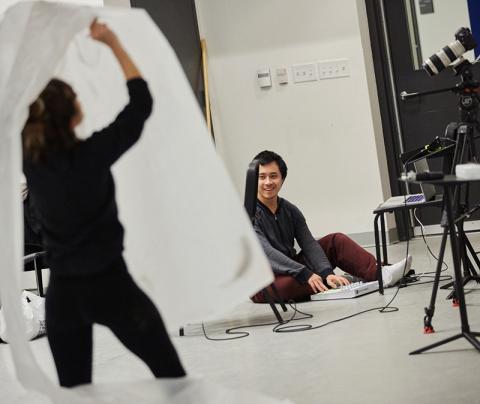Berklee, Boston Conservatory Students Merging in Art

“We are a collaborative improvisational ensemble experimenting with music, dance, and visual arts,” says Juliano Vendemiatti (center), the Berklee student who, in collaboration with others at Berklee and The Boston Conservatory, launched the ongoing workshops in the fall 2015 semester.
Dave Green

Cathy Young, director of the Dance Division at The Boston Conservatory, discusses how Berklee musicians might relate to the dance form of contact improvisation: “One of the definitions I really like is ‘composing in the moment.’ It’s making thoughtful compositional choices in real time.”
Dave Green

“Our dance students are already in collaboration with Berklee composers all the time, but now we’re creating even more opportunity for that to happen,” says Young.
Mike Keefe-Feldman

“One of the primary benefits for Berklee Interdisciplinary Arts Institute (BIAI) students has been the opportunity to see how artists from other fields conceptualize and produce their work,” says BIAI artistic director Neil Leonard of collaborations between the Conservatory and Berklee.
Mike Keefe-Feldman

“At certain points, there was so much available to me—the drawings, the objects, the people, the music—and I could feel myself holding back," says Boston Conservatory student Jenna Mitchell (pictured). "Every time I felt that, I had to acknowledge it in order to get to, ‘Let’s go right for it.’”
Mike Keefe-Feldman

“Everybody was flowing on their own but also acknowledging one another,” Mitchell says. “It was very strange and wonderful.”
Dave Green

“There is so much energy going through that it is hard to hold,” says Vendemiatti. “Singularity is a philosophical concept that is very important to me. I don’t want to see what’s common about you. I want to see what’s unique—what only you can bring. I want people to bring their singularity to this.”
Mike Keefe-Feldman

Student interdisciplinary arts sessions will be held Thursday nights throughout the spring 2016 semester until April 28.
Dave Green
In Studio 306 at The Boston Conservatory’s Ipswich Street building, student instrumentalists, visual artists, dancers, actors, and electronic musicians from Berklee and the Conservatory sit in a circle, sharing their interests, ideas, and stories. With trust in one another’s sincerity in pursuit of artistic exploration, an interdisciplinary arts experiment begins. The boundaries are blurry, if they exist at all. A dancer draws on a canvas. A violinist dances while an electronic musician adapts his controller's soundscapes to the collective's energy.
All are focused on the music, movements, and expressions conveyed by the other members of this group of seven, and while no one speaks using words, a conversation takes place. Over the next two hours, students from Berklee and The Boston Conservatory—whose institutions have agreed to merge—demonstrate that, in art, they have already begun doing so.
Breaking Down Barriers
Juliano Vendemiatti, a Berklee student currently taking a semester off but planning to return to his studies in the fall, proposed these interdisciplinary arts workshops between the two institutions. Vendemiatti plays violin, didgeridoo, harmonium, percussion, flute, and the traditional Brazilian rabecão, a stringed instrument from his native country. A classically trained musician, Vendemiatti spent eight years studying butoh dance in Brazil and Japan, and his interests extend to the Feldenkrais method, the Seitai technique, art research, conceptual art, and the philosophy of art.
“I came to Berklee mainly because of Neil Leonard and the Berklee Interdisciplinary Arts Institute (BIAI), and because I knew that there was this space” for cross-discipline collaboration at Berklee, Vendemiatti says.
The interdisciplinary jam sessions began as a project of the BIAI, and Leonard, the institute’s director, notes, “This is one of many projects that the BIAI and Boston Conservatory have partnered on over the years,” some of them involving elaborate choreography and large-scale productions. Such collaborations, Leonard says, force his students to “work outside of their comfort zone”—an artistic challenge that also found support from Cathy Young, director of the Dance Division at The Boston Conservatory. She connected Vendemiatti with senior Conservatory faculty member Olivier Besson—an expert in the contact improvisation prevalent at these sessions—to get the project off the ground, along with additional guidance from Alissa Cardone, another member of the Conservatory’s dance faculty.
“I love the idea that this kind of project creates a space where musicians can dance if they want to, and dancers can paint if they want to, because I think that’s going to be the performing arts of the future,” Young says. “It’s going to be this melding of forms and this breaking down of barriers. In a way, it reminds me of the '60s but with a 21st century approach.”
Endless Possibilities for Collaboration
One of the students who has participated in the project is Jenna Mitchell, a second-year Boston Conservatory student from Dallas/Plano, Texas, focused primarily on dance. As Mitchell recounts a recent session, “What happened that night was really magical. There was a merging of everyone’s own art form so that it became almost one singular consciousness. Something of our selves merged and became this one thing that you can’t really describe, but it happened.”
The experience had a lasting impact outside of the session’s walls, Mitchell says. “These collaborations can really fuel you. When I went home that night, I was writing and choreographing in my notebook,” she says.
Mitchell has several friends who are Berklee students and points to a commonality between those studying at Berklee and the Conservatory, a quality she summarizes as “a crazy passion and an inability to leave the mindset of creating.”
To many at each institution, including Leonard and Young, these workshops are just a small glimpse of a merger that made intuitive sense long before each institution’s president signed an official merger document.
“The possibilities are endless, and it’s already happening,” Young says, pointing to examples such as Berklee student musicians working with Conservatory choreographers and dancers to create a music video.
Young says she is particularly excited for her faculty and students to tap into what she sees as Berklee’s can-do spirit: “I see that in students like Juliano, who says, ‘Okay, I have this idea. I’m going to make it happen,’” Young says. “I think if we can be a world-class arts institution that is helping to nurture that kind of agency in our students, we’re going to be doing something that is really unique in the world.”
The Berklee/Boston Conservatory interdisciplinary arts experiments will resume on Thursday, February 25, from 7:00 p.m. to 9:00 p.m. in Studio 306 at The Boston Conservatory campus building at 132 Ipswich Street in Boston. Sessions will continue every Thursday night this semester through April 28, and students are invited to attend as participants and as audience.
